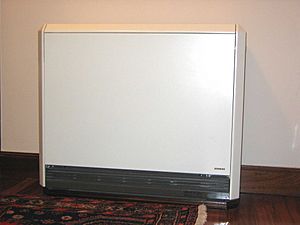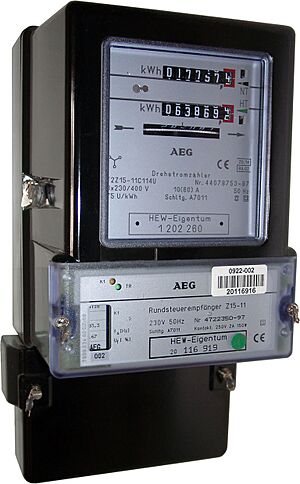Storage heater facts for kids
A storage heater is a special electric heater that stores heat. It works by warming up during the night when electricity is cheaper. Then, it slowly releases this heat into your home during the day. In Australia, these are sometimes called heat banks. They help you use electricity more wisely and save money on heating bills.
Contents
How Storage Heaters Work
Storage heaters are usually filled with special materials. These can be clay bricks, other ceramic parts, or even water. These materials are great at holding onto heat. Inside, there are electric heating parts. When you turn them on, these parts heat up the storage material. This way, the heater stores energy as heat.
The stored heat then slowly comes out into the room. It spreads through thermal radiation (like warmth from the sun) and convection (warm air moving around). Some storage heaters even have small fans. These fans can blow air through the heater to spread the warmth faster.
Types of Storage Heaters
Modern High Heat Retention Heaters
The newest and best storage heaters are called High Heat Retention Storage Heaters (HHRSH). Companies like Dimplex helped create this new type of heater. These heaters are much better at keeping heat inside. They can hold at least 45% of their heat for 24 hours after being fully charged. This means less heat is wasted during the day.
They achieve this by using better insulation. Also, these modern heaters have smart controls. They can check the weather and guess how much heat you will need. This makes them much more responsive than older models. All new high heat retention heaters follow special rules called "Lot 20" from January 1, 2018.
Important Rules for Heaters
"Lot 20" is a set of rules made to make heating systems more efficient. It helps reduce the energy used to heat homes. The goal is to lower carbon emissions and help the environment. These rules started on January 1, 2018.
They say that all new electric heaters must have an electronic thermostat. This thermostat needs a timer that works for 24 hours and 7 days. It should also have smart features like "adaptive start" (learning when to turn on) or an "open window sensor." Storage heaters specifically need:
- An electronic control for how much heat they charge.
- A room temperature control with a weekly timer.
- A fan to help push out heat (if it's a fan-assisted model).
Some heaters also have extra features like remote control or open window detection. Older heaters made before 2018 can still be sold.
Where Storage Heaters Are Used
Storage heaters are often used with a special electricity meter. This meter records electricity used at different times. It charges less for electricity used during "off-peak" hours (usually at night). To get these lower prices, your house needs to be on a special electricity plan. In many places, storage heaters only save you money if you use them with such a plan. In the United Kingdom, the "Economy 7" plan is a good example.
Storage heaters usually have two main controls:
- Charge control (or "input"): This sets how much heat the heater stores overnight.
- Draught control (or "output"): This sets how fast the heat is released during the day.
You can set these controls yourself, or some heaters have a thermostat. A thermostat lets you choose a target room temperature, and the heater adjusts itself. Some storage heaters also have an extra electric heater. This can give you more heat if needed, but it uses regular, more expensive daytime electricity.
Comparing Storage Heaters to Other Heating Systems
Good Things About Storage Heaters
- Cheaper to run: They are often cheaper to use than other electric heaters that run all day. They use cheaper night-time electricity.
- Warm mornings: Since they charge at night, your house can be warm in the morning. Other heating systems might be off at night to save money, making the house cold.
- Good for some areas: You can use them in places where natural gas pipes are not available. This saves you from paying high daytime electricity rates for heating.
- Easy to install: They are cheaper to buy and much easier to put in than a gas central heating system with pipes and radiators. This is great for older buildings.
- Low maintenance: Compared to gas heating, storage heaters need almost no maintenance.
Not-So-Good Things About Storage Heaters
- Heat loss: Some heat is always lost while the heater is charging overnight. The room gets warm in the morning because heat has been slowly leaking out all night.
- Fixed heat: The heat stored at night will come out during the day, even if you don't need it. If you leave the house unexpectedly, the heat you paid for will still be released.
- Limited heat: They can only heat with the energy stored the night before. If you didn't store enough heat (e.g., if the weather suddenly gets colder), you might not have enough warmth for the day. You can only fix this for the next day.
- Can be tricky to use: Some people find the controls confusing. For example, leaving the "output" control open at night means heat escapes when it should be stored, costing more money.
- Big and heavy: Storage heaters are very heavy and take up more floor space than regular radiators. This is because of the material inside that stores heat.
- Dust: If a fan is used to spread heat, it can increase dust in the air. This might be a problem for people with allergies.
Using Storage Heaters Well
Storage heaters can save you money if you use them correctly. They need a bit more attention than other heating systems.
Power Switches
Storage heaters usually have two power circuits. One uses cheaper "off-peak" electricity (at night), and the other uses regular "on-peak" electricity (during the day). You turn them off in summer when you don't need heat. During colder months, you can leave the "off-peak" switch on. The "on-peak" switch is used only if you didn't store enough heat overnight. You can change how much heat is stored using the controls on the heater.
Basic Controls Explained
Simple storage heaters have an "input" switch and an "output" switch (sometimes called "heat boost").
The input switch controls how much heat is stored. You can change it based on how cold you expect the next day to be. This switch is often controlled by a thermostat. It stops charging when the room reaches a certain temperature overnight. You might need to experiment to find the best setting for your room. In the middle of winter, you might set it to maximum. You don't need to touch the input switch every day if the weather stays the same. Remember, storage heaters only use electricity at night for charging.
The output switch needs more attention during the day. Before bed, set it to its lowest setting. This keeps as much heat as possible inside the heater. Enough heat will still come out to make the room warm in the morning. Only in very cold weather might you need output overnight. During the day, you can slowly increase the output to keep the house warm. Increasing the output lets more heat flow out. If no one is home during the day, leave the output at minimum. Then, turn it up when you get home to release more heat.
Some output switches are automatic. If you don't set them to minimum overnight, they will close automatically. Then, they will reopen after a delay. This delay depends on how much heat is stored.
Smart Thermostat Controls
A storage heater with a thermostat will automatically keep the room at a set temperature all day. However, you might want to set the thermostat to a lower temperature overnight to save energy. If the room is empty during the day, keep the thermostat low. Then, increase it when people are in the room in the evening. Be aware that some smart heaters might use more expensive daytime electricity if there isn't enough stored heat to reach the set temperature.
Fan-Assisted Storage Heaters
These heaters use an electric fan to push air through them. This is different from relying only on natural air movement. The fan is usually controlled by a thermostat, letting you set the exact room temperature you want. Because they use a fan, these heaters can have better insulation. This means they lose less heat when you don't need it, like when the room is empty or at night.
Environmental Impact
Like other electric heaters, storage heaters' environmental impact depends on how the electricity is made. If electricity comes from fossil fuels (like coal or gas), then heating with electricity might not be very green. A lot of energy can be lost when making and sending electricity. Some countries have even limited or banned direct electric heating for this reason.
However, many countries are now using more renewable energy sources like wind and solar power. So, how "green" a storage heater is depends on where your electricity comes from. Storage heaters can be useful because they can use electricity when there's a surplus, for example, from wind farms at night when demand is low. This could make them more important in the future with smart energy systems.
Compared to other electric heaters, storage heaters use less electricity during peak times. They are also cheaper to run. Other options like heat pumps can be even more efficient, using much less electricity by taking heat from the ground. For new buildings, very energy-efficient designs, like those following the "Passive House" standard, can almost remove the need for traditional heating systems.
See also
In Spanish: Acumulador de calor (calefacción) para niños



